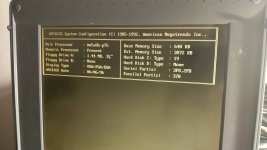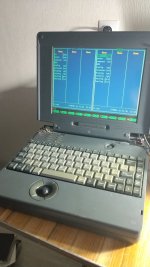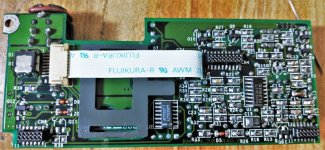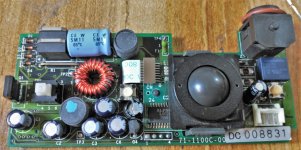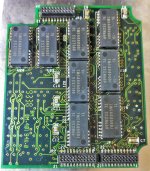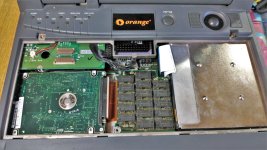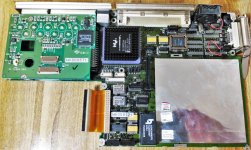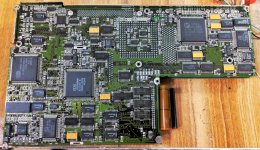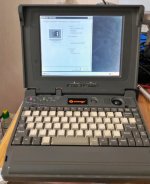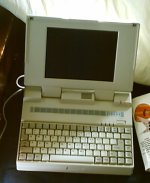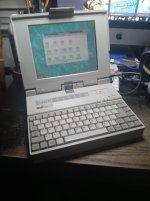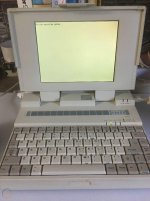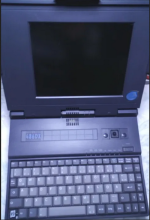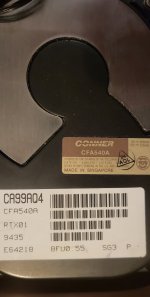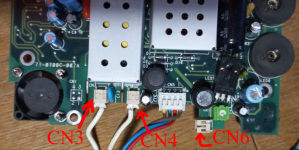I wish I could edit the first post I made and add more pictures because there's a whole heck of a lot more of these machines. I have them on my website at -
https://creepingnet.neocities.org/computer/mydocs/hardware/nantanmain - which I also have two extended pages for the FMA3500 and FMAK9200/FMAP9200 models - which I now own one of each. So I will detail those since I've gotten to know them more.
FMA3500 SERIES - The FMA3500 Series were basically a 486 version of the FMA3300 and came in the same. They came in both white and gray, and were available with all three available screen technologies of the time: a black and white Casio 9.4" STN monochrome display, a Sanyo LC-533-22NTK 9.4" DSTN Color Display, and an unknown Active Matrix Display (far right). They also are known as the "486 DX Professional" laptop because that's what's printed on the top of the case above the keyboard on all versions. Non Trackball versions have it on the right, trackball versions on the left.
Model Designations are as Follows
FMA3500 - i486 DX-33, 4MB RAM (SIP), no trackball, b&w Casio 9.4" STN Display, 4-pin power
FMA3500SX - i486 SX-33, 4MB RAM (SIP) no trackball, b&w Casio 9.4" STN Display, 4-pin power
FMA3500C - i486 DX-33, 8MB RAM (SIP), Trackball, color DSTN 9.4" display, barrel jack
FMA3500C - i486 DX-33, 8MB RAM (SIP), trackball, color Active Matrix 9.4" Display, barrel jack
FMA3540 - i486 DX2/SX/DX, SIP RAM, no trackball, b&w 9.4" STN Display, unknown power
Graphics is provided via a Cirrus Logic CL GD-542X series graphics chipset with 1MB of VRAM. The color versions have a daughtercard for their associated video hardware. The 3540 model was a later model likely designed to offer the DX2/50MHz CPU - so it has a 25MHz bus instead of a 33MHz one.
Memory is upgraded via 4 SIP slots inside the case. Theoretically the maximum is 32MB of RAM. You might be able to replace these with 30 pin SIMM Slots.
Expansion was provided by removing the 12 volt 3600mAH NiCad battery from the back via 2 thumbscrews, and then attaching a docking station attachment instead that gave the computer two ISA Slots to add cards to. This unit attaches to a proprietary expansion connector on the back of hte laptop which may be ISA compatible.
These were sold as the BSi NP486DX33, BSi NP486SX33, BSi NP486DX266, and BSi NP486DX250, as well as many others are seen with Highscreen, Eurocom, and Ergo branding on them.

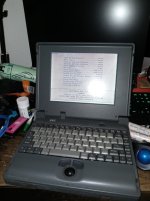
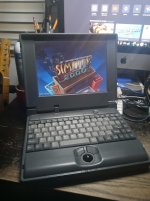
(Left->Right): Duracom 5110D (mine, 2005), DFI Mediabook SX25 (mine, 2022), NanTan FMAK9200C (mine, 2023)
FMAK9200 & FMAP9200 - The FMAK9200 and FMAP9200 (not sure what the K and P means) were "Multimedia" laptop computers, and may have similar models in the 9400 series if parts cross referencing is any sort of indication. They feature a mid-sized trackball with two nice clickey buttons above it intended below the keyboard, and a somewhat spongey rubber dome keyboard.
They use a "Socket 1" type setup underneath the keyboard but it is 3.3v compatible, I had a 486 DX4-100 of both AMD and Intel varieties in here. They are often found with also a 486 SX-25, DX-33, or DX2-66 made by intel or Cyrix. It seems AMD CPU's have some issues with these. However they are screamin' fast even at DX2 speed.
The graphics are provided via a Cirrus Logic CL-GD 6440 1MB SVGA Graphics chipset with a choice between a Casio 9.4" STN monochrome display, or a 10.3" Sanyo LCD in DSTN. I don't think these were made in active matrix. The screen does not turn off with the lid closed - so the computer can heat the screen and possibly damage or improve it. It seems the latter is the case with mine. This chipset has some problems, such as corrupt text in Sim City (fixed by using TSRFONT.COM from Cirrus), and 3D Body Simulator won't even work with this system (Edutainment title teaching anatomy).
Sound is provided via a ESS488 audio chipset. This is a SoundBlaster 2.0 compatible chipset with OPL/2, and outputs in mono only despite stereo headphones working with it. It also provides ports for line-in and microphone in. It does act up in some games (Monkey Island in particular) which can be fixed with a patch. Internal speaker DOES NOT go through the audio jack/headphones unfortunatley. There is also a startup "chime" that you can enable and disable either through the BIOS, or through a row of eight DIP Switches found under the proprietary memory slot (4MB is on-board, 8MB is a common config). The DIP switches also apparently configure IRQs, Memory Addresses, and other stuff for the Hard Disk controller and on-board ESS 488 sound card, as well as I think there's a "burn in" mode. DIP Switch #1 (closest to screen) turns the Chime off.
The CPU can be configured via a series of Jumpers found next to the CMOS battery (button cell), I have not figured all of the jumper settings out yet. I wish I had manuals for this stuff TBH. Would be need to see the system builders who fleshed these out back in the day from their perspective.
All of these models had 2x 16-bit Type II PCMCIA Slots with an apparent gap up top to allow one Type III sized card and one type II card. It seems most of these I've run across have Toshiba 250MB HDDs that are still running strong at 30 years old (I still have the one from my current NanTan).
Power was provided via a 19.5vdc Power Supply, or via 2 9.6vdc 1800mAH NiMH Batteries located just under the palm wrest - each with their own individual charging status lights, and the built-in microphone is located in-between them.
I have seen these sold as generic (like my current one), DFI MediaBook, Duracom (5110D), Liberty, Hyperbook, Milkyway Myriadbook, and the Prostar 9200M (which was the first one I bought back in '03).

